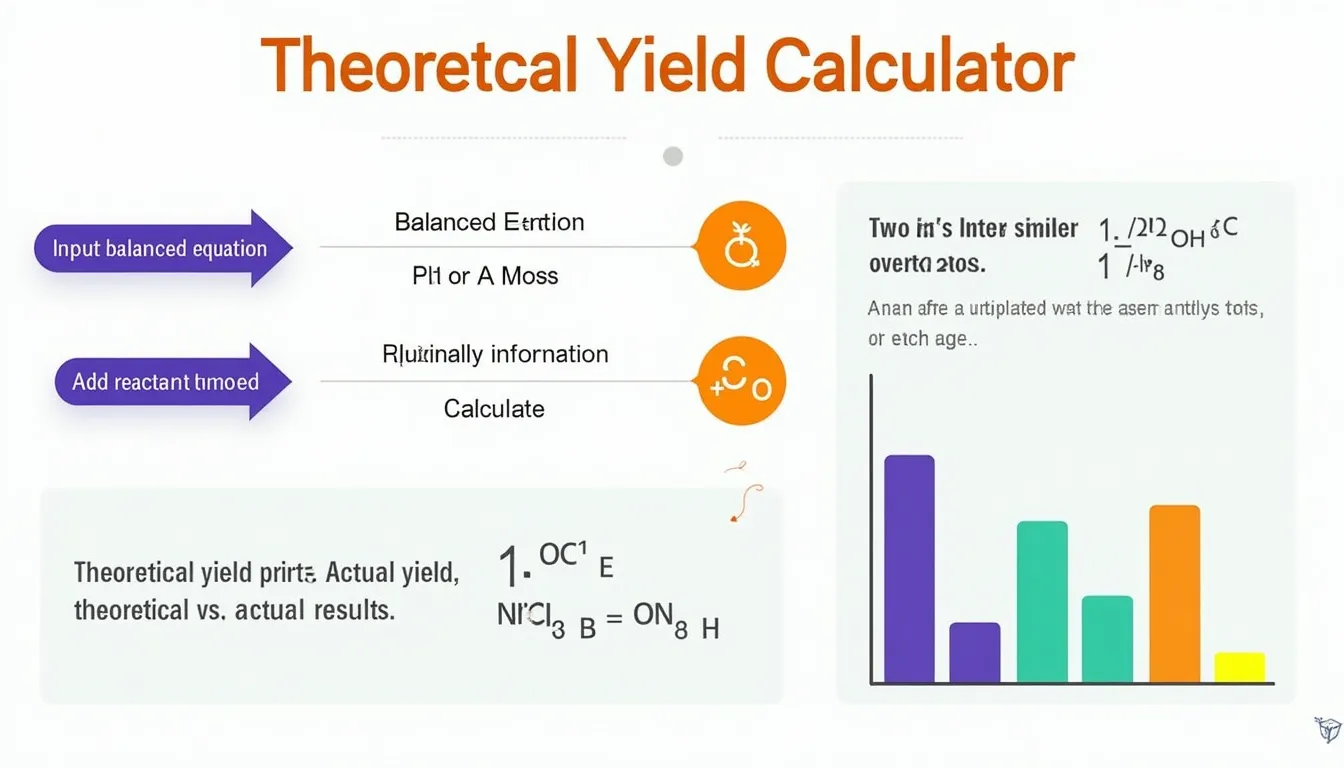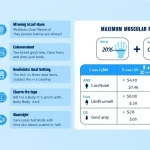Theoretical Yield Calculator
Is this tool helpful?
How to use the tool
- 1 — Balanced equation: type it exactly as written in textbooks. Example A: “4Fe + 3O2 -> 2Fe2O3”. Example B: “2KClO3 -> 2KCl + 3O2”.
- 2 — Reactant name: enter each formula (e.g., Fe, O2, KClO3).
- 3 — Reactant mass (g): supply the weighed amount—e.g., 55.8 g Fe or 24.5 g KClO3.
- 4 — Run calculation: press “Calculate Theoretical Yield” to see the limiting reactant and maximum product mass.
- 5 — Iterate: change any mass to explore how yield responds.
Underlying formulas
All steps follow classical stoichiometry.
- Moles of reactant $$n = rac{m}{M}$$
- Mole ratio check $$ rac{n_i}{\text{coeff}_i}$$ —smallest value reveals the limiting reactant.
- Theoretical yield (grams) $$m_{\text{prod}} = n_{\text{lim}} \times rac{\text{coeff}_{\text{prod}}}{\text{coeff}_{\text{lim}}} \times M_{\text{prod}}$$
Worked example A
Reaction: 4Fe + 3O2 → 2Fe₂O₃
- Moles Fe = 55.8 g / 55.85 g mol⁻¹ = 1.00 mol
- Moles O₂ = 32.0 g / 31.998 g mol⁻¹ = 1.00 mol
- Fe ratio 1.00/4 = 0.25 (smallest) → Fe limits
- Moles Fe₂O₃ = 0.25 × 2 = 0.50 mol
- Mass Fe₂O₃ = 0.50 × 159.69 g mol⁻¹ = 79.8 g
Worked example B
Reaction: 2KClO₃ → 2KCl + 3O₂
- Moles KClO₃ = 24.5 g / 122.55 g mol⁻¹ = 0.200 mol
- Limiting reactant: KClO₃ (only reactant)
- Moles O₂ = 0.200 × 3 / 2 = 0.300 mol
- Mass O₂ = 0.300 × 31.998 g mol⁻¹ = 9.60 g
Quick-Facts
- Avogadro constant is exactly 6.022 140 76 × 10²³ mol⁻¹ (NIST CODATA, 2019).
- Standard atomic weights are published by IUPAC every two years (IUPAC Table, 2021).
- Average student-lab percent yield: 79 % of theoretical (RSC Lab Report, 2020).
- Limiting-reactant analysis underpins 12 principles of green chemistry (UNEP Green Chemistry, 2021).
FAQ
What is theoretical yield?
Theoretical yield is the maximum product mass predicted from the limiting reactant under ideal conditions (Zumdahl, 2020).
Why must I balance the equation first?
Balanced coefficients fix mole ratios; incorrect ratios give wrong limiting reactants and yields (Masterton, 2018).
How do I obtain molar mass quickly?
Add each element’s atomic weight from the IUPAC table; many periodic-table apps list totals automatically (IUPAC, 2021).
Can I enter fractional coefficients?
Yes—enter decimals like 0.5O₂; the calculator scales ratios internally.
How many reactants are supported?
The interface adds up to ten reactant rows per calculation.
Does the tool handle gaseous reactants?
Yes—input their mass in grams; the ideal-gas volume step is unnecessary.
How is the limiting reactant chosen?
The algorithm divides each reactant’s moles by its coefficient and selects the smallest quotient.
How do I find percent yield?
Measure actual product, divide by theoretical yield, multiply by 100; “Percent yield quantifies efficiency” (ACS Guidelines, 2022).
Important Disclaimer
The calculations, results, and content provided by our tools are not guaranteed to be accurate, complete, or reliable. Users are responsible for verifying and interpreting the results. Our content and tools may contain errors, biases, or inconsistencies. Do not enter personal data, sensitive information, or personally identifiable information in our web forms or tools. Such data entry violates our terms of service and may result in unauthorized disclosure to third parties. We reserve the right to save inputs and outputs from our tools for the purposes of error debugging, bias identification, and performance improvement. External companies providing AI models used in our tools may also save and process data in accordance with their own policies. By using our tools, you consent to this data collection and processing. We reserve the right to limit the usage of our tools based on current usability factors.







